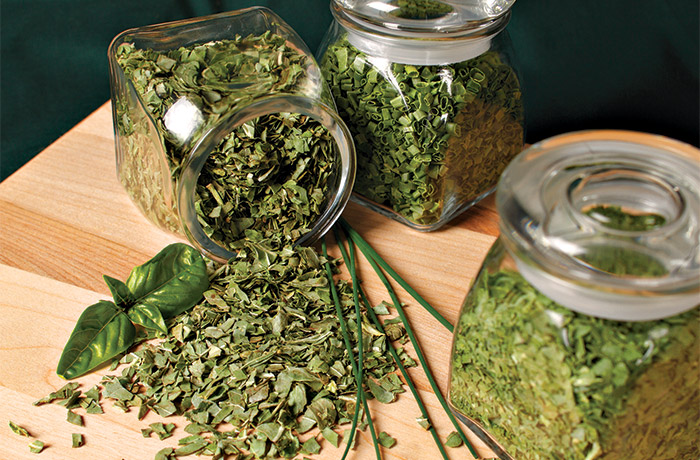Herbs are a great way to enhance your everyday meals. They can add new flavors and colors to common foods. Freezing and drying herbs when they’re plentiful allows you to use them later.
Most herbs are at peak flavor when flower buds first appear, before they are fully open.

- Pick herbs in the morning, just after the dew evaporates and before the sun is hot.
- Discard bruised, soiled or imperfect leaves and stems.
- With the leaves on the stems, lightly wash in cool running water.
- Gently shake to remove excess water.
- Drain on paper towels
Freezing herbs
Frozen herbs can work for cooking, though they are usually not suitable for garnish as they become limp when thawed.
Options for freezing herbs
- Place a few sprigs or leaves in freezer wrap or in an airtight freezer container.
- Spread on a tray or cookie sheet and place in the freezer. When frozen solid, pack into airtight containers.
- To use in soups or stew, dice washed herbs and pack into ice cube trays. Fill the spaces with water. When frozen, pop out cubes and store in airtight containers.
For cooked dishes, use the same amount of frozen herbs as you would fresh ones.
Herbs for Freezing
Herbs marked with can be frozen on the stems.
- Basil (retains flavor, but discolors)
- Chervil
- Cilantro
- Chives
- Dill
- Lemon balm
- Lemon verbena
- Lovage
- Mint
- Oregano
- Parsley
- Rosemary
- Sage
- Savory
- Sorrel
- Sweet cicely
- Sweet marjoram
- Tarragon
- Thyme
Drying herbs
The time it takes in ovens or food dehydrators varies with the herb and appliance used. Herbs are dry when leaves crumble off the stem. Don’t crush leaves until using them – they’ll lose their flavor more quickly.
Air drying in Minnesota is difficult because of the weather. Ideal conditions are consistent temperatures above 85 F and humidity below 60 percent.
Herbs for Drying
- Basil
- Dill
- Fennel
- Lovage
- Mint
- Oregano
- Parsley
- Rosemary
- Sage
- Savory
- Scented geraniums
- Tarragon
- Thyme
Using a food dehydrator
Dehydrator drying is a fast and easy way to dry high quality herbs. Set the thermostat to 95 to 115 degrees F. Place washed herbs in a single layer on dehydrator trays. Drying time varies from 1 – 4 hours. Check your dehydrator instruction booklet for exact temperature and drying times. Check often until leaves crumble and stems break when bent.
Using a microwave
Parsley, basil and celery leave dry well in some microwave ovens with a wattage rating of 1,000 or less for 2-3 minutes. Place herbs in a single layer on a paper towel and cover with a second paper towel. Check every 30 seconds, rotating the herbs. Continue checking every 30 seconds until dry. Remove herbs that are dry and brittle to prevent hot spots causing the paper towel to catch fire. Continue drying for 30-second intervals until all pieces are dry and brittle.
Oven drying
Oven drying is especially good for mint, sage or bay leaf. Remove the leaves and dry individually instead of drying whole stems. Spread washed leaves in a single layer on a shallow baking pan. Dry at temperatures of 110 – 130 degrees F. The pilot light on a gas oven or the oven light in an electric oven is enough heat for overnight drying. Dry for 3 to 4 hours. Stir herbs periodically until thoroughly dry.
Indoor air-drying
Indoor air or room drying is an option for sturdy herbs like rosemary, sage, thyme and parsley. Stems of herbs such as mint, sage or thyme can be tied in a small cluster and hung in a dry area with good air circulation. Tie stems together with a rubber band into a cluster. Hang herbs away from the sink, stove or dishwasher where there is a lot of moisture.
Vine Drying
Vine drying is a type of sun drying and works well for coriander, dill, caraway, mustard, and fennel. Simply leave it on the vine in the garden. When the vines, leaves, stems or seeds are dry and shriveled, harvest them and remove them from the stem. If still moist, the drying process is not complete and it will mold. Complete the drying process in the oven, dehydrator or air dry in a room.
Herbs are sufficiently dry when leaves are crispy and crumble easily between the fingers.
Place them in airtight containers or jars with tight-fitting lids. Glass keeps aromas in. Herbs must be completely dry or they mold. Store in a cool, dry, dark area, away from light and heat. Dried herbs keep their flavor and color three months in cupboards and up to one year in refrigerators or freezers. To substitute dried herbs, use a generous 1/4 teaspoon ground or 1 teaspoon crumbled dried leaves for every 1 tablespoon of fresh chopped herbs.
We at KERONE have a team of experts to help you with your need for freezing and drying systems of herbs in various products range from our wide experience.
